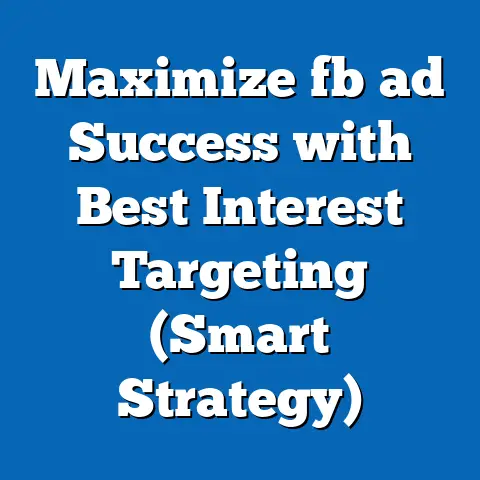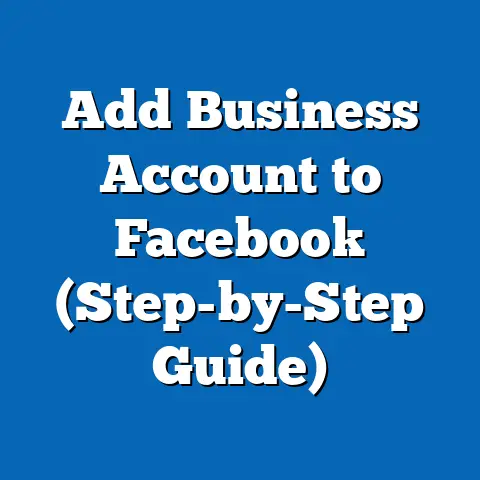Understand Facebook Ads Billing (Essential Insights)
Facebook advertising has become an indispensable tool for businesses aiming to connect with a vast and diverse audience. With billions of active users, Facebook provides unparalleled opportunities for reaching potential customers. However, navigating the complexities of Facebook Ads requires more than just creative ad design and strategic targeting. One crucial aspect that often gets overlooked is understanding Facebook Ads billing. I’ve seen firsthand how mastering the billing process can significantly impact the efficiency and success of your campaigns. In this guide, I’ll walk you through everything you need to know about Facebook Ads billing, ensuring that you can manage your advertising budgets with ease and confidence.
Understanding Facebook Ads Billing
At its core, Facebook Ads billing is the process by which Facebook charges you for the ads you run on its platform. It encompasses everything from setting up your payment methods to understanding billing cycles, managing budgets, and resolving any billing issues that may arise. A solid grasp of these elements is essential because it directly affects your ability to run ads smoothly and effectively.
Think of it this way: your billing setup is the engine that powers your Facebook Ads campaigns. If the engine isn’t running smoothly, your entire advertising strategy can stall. I remember once working with a client who had their ads abruptly paused due to a billing issue. They lost valuable time and potential leads because they hadn’t properly configured their payment settings. That experience taught me the importance of getting the billing details right from the start.
Understanding Facebook Ads billing is not just about avoiding disruptions; it’s also about optimizing your spending. When you know how Facebook charges you, you can make smarter decisions about your budgets and bidding strategies. This knowledge empowers you to maximize your ROI and achieve your marketing goals more efficiently.
Key Takeaway: Facebook Ads billing is a critical component of your advertising strategy. A thorough understanding of the billing process is essential for running ads smoothly, optimizing your budget, and maximizing your ROI.
Billing Cycles Explained
Facebook offers different billing cycles to accommodate various advertising needs and preferences. The billing cycle determines when and how you are charged for your ad spend. Understanding these cycles is crucial for effective budget management.
Here are the primary billing cycles you need to know:
- Spending Threshold: This is the most common billing cycle. Facebook charges you each time your ad spend reaches a specific threshold. For example, your initial threshold might be $25. Once your ad spend hits this amount, Facebook will charge your payment method. As you consistently pay on time, Facebook may gradually increase your threshold, up to a certain limit.
- Monthly Billing: If you don’t reach your spending threshold within a month, Facebook will charge you at the end of the month, regardless of how much you’ve spent. This ensures that you’re always up-to-date with your payments.
- Daily vs. Lifetime Budgets: The type of budget you choose also affects your billing. With a daily budget, you set an average amount you’re willing to spend each day. Facebook will then attempt to spread your spend evenly throughout the day. With a lifetime budget, you set a total amount you’re willing to spend over the entire duration of your campaign. Facebook will then optimize your ad delivery to make the most of your budget.
The billing cycle you choose can significantly impact your cash flow. For instance, if you have a limited budget, you might prefer a lower spending threshold to avoid large, unexpected charges. On the other hand, if you’re running a long-term campaign, a higher threshold might be more convenient.
I once worked on a campaign where we were testing multiple ad sets with varying budgets. Initially, we used a low spending threshold, which resulted in frequent charges. This made it difficult to track our overall ad spend accurately. After switching to a higher threshold, we found it much easier to manage our budget and analyze our performance data.
Key Takeaway: Facebook offers different billing cycles, including spending thresholds and monthly billing. The type of budget you choose (daily or lifetime) also affects your billing. Understanding these cycles is essential for effective budget management and cash flow.
Payment Methods Available
Facebook accepts a variety of payment methods to make it convenient for advertisers around the world. The payment methods available to you may vary depending on your location, but here are the most common options:
- Credit Cards: This is the most widely used payment method. Facebook accepts major credit cards such as Visa, Mastercard, American Express, and Discover. Using a credit card is straightforward and allows you to track your ad spend through your credit card statements.
- PayPal: PayPal is another popular option, especially for those who prefer not to share their credit card details directly with Facebook. It’s a secure and convenient way to pay for your ads.
- Direct Debit: In some countries, Facebook allows you to pay directly from your bank account via direct debit. This can be a convenient option if you prefer not to use credit cards or PayPal.
- Local Payment Methods: Depending on your location, Facebook may also offer local payment methods such as iDEAL in the Netherlands or Boleto Bancário in Brazil. These options cater to specific regional preferences and banking systems.
Each payment method has its own advantages and disadvantages. Credit cards offer convenience and the ability to earn rewards points, but they may also come with interest charges if you don’t pay your balance on time. PayPal provides an extra layer of security, but it may involve transaction fees. Direct debit can be convenient, but it requires you to share your bank account details with Facebook.
I’ve found that using a dedicated credit card for Facebook Ads can be a smart move. It allows you to easily track your ad spend separately from your other business expenses. Plus, you can earn rewards points or cashback on your advertising spend, which can add up over time.
Key Takeaway: Facebook accepts various payment methods, including credit cards, PayPal, direct debit, and local payment options. Each method has its own pros and cons, so choose the one that best suits your needs and preferences.
Budgeting for Facebook Ads
Budgeting is a critical aspect of any Facebook Ads campaign. It involves determining how much you’re willing to spend on your ads and allocating that budget effectively to achieve your marketing goals. A well-defined budget not only ensures that you don’t overspend but also helps you optimize your campaigns for maximum ROI.
Here are some key considerations when budgeting for Facebook Ads:
- Define Your Goals: Before setting a budget, clarify what you want to achieve with your ads. Are you looking to increase brand awareness, generate leads, drive website traffic, or boost sales? Your goals will influence the amount you need to spend.
- Understand Your Audience: Knowing your target audience is essential for effective budgeting. If you’re targeting a niche audience, you may need to spend more to reach them. On the other hand, if you’re targeting a broad audience, you can potentially achieve results with a smaller budget.
- Consider Your Industry: The cost of advertising on Facebook can vary significantly depending on your industry. Highly competitive industries, such as finance and insurance, tend to have higher ad costs. Research industry benchmarks to get a sense of what you should expect to pay.
- Choose the Right Budget Type: As mentioned earlier, Facebook offers daily and lifetime budgets. A daily budget is ideal for campaigns that run continuously, while a lifetime budget is better for campaigns with a specific end date.
- Monitor and Adjust: Your budget shouldn’t be set in stone. Regularly monitor your campaign performance and adjust your budget as needed. If you’re seeing positive results, you may want to increase your budget to scale your efforts. If your results are lackluster, you may need to reduce your budget or refine your targeting.
I’ve learned that it’s always better to start with a smaller budget and gradually increase it as you see results. This allows you to test different ad creatives, targeting options, and bidding strategies without risking a large amount of money.
Key Takeaway: Budgeting is a critical aspect of Facebook Ads. Define your goals, understand your audience, consider your industry, choose the right budget type, and monitor and adjust your budget as needed.
Common Billing Issues and Solutions
Even with a solid understanding of Facebook Ads billing, you may encounter issues from time to time. Here are some common billing problems and how to resolve them:
- Failed Payments: This is perhaps the most common billing issue. It can occur for various reasons, such as insufficient funds, an expired credit card, or a problem with your payment method. To resolve this, first, ensure that your payment method is valid and up-to-date. If the issue persists, try adding a different payment method.
- Unexpected Charges: Sometimes, you may see charges that you don’t recognize. This can happen if you’ve accidentally set a high budget or if your ads are performing better than expected. Review your campaign settings and budget to ensure they’re accurate. If you still can’t identify the charge, contact Facebook support.
- Ad Account Disabled: Facebook may disable your ad account if it detects suspicious activity or if you violate its advertising policies. To resolve this, you’ll need to contact Facebook support and provide any information they request.
- Billing Threshold Not Reached: If you’re using a spending threshold, you may find that your ads are not running as frequently as you’d like because you’re not reaching the threshold quickly enough. In this case, you can either increase your budget or switch to a different billing cycle.
When dealing with billing issues, it’s essential to act quickly. The longer the issue remains unresolved, the more your campaigns will be disrupted. Don’t hesitate to reach out to Facebook support for assistance. They can provide valuable insights and help you resolve complex billing problems.
Key Takeaway: Common billing issues include failed payments, unexpected charges, ad account disabled, and billing threshold not reached. To resolve these issues, ensure your payment method is valid, review your campaign settings, and contact Facebook support if needed.
Monitoring and Managing Your Billing
Monitoring and managing your billing is an ongoing process that involves regularly reviewing your ad spend, analyzing your performance data, and making informed decisions about your advertising strategy. Facebook provides several tools and features within Ads Manager to help you stay on top of your billing.
Here are some key steps to take:
- Check Your Billing Summary: The Billing Summary in Ads Manager provides an overview of your ad spend, payment history, and billing settings. Review this summary regularly to ensure everything is accurate.
- Analyze Your Ad Performance: Your ad performance data can provide valuable insights into your billing. For example, if you’re seeing a high cost per click (CPC) or cost per acquisition (CPA), you may need to adjust your bidding strategy or refine your targeting.
- Set Up Billing Alerts: Facebook allows you to set up alerts to notify you of important billing events, such as when your payment method is charged or when your ad account reaches a certain spending threshold. These alerts can help you stay informed and take action quickly if needed.
- Use Budget Rules: Budget Rules allow you to automate certain aspects of your budget management. For example, you can set a rule to automatically pause your ads if your ad spend exceeds a certain amount.
- Regularly Update Payment Information: Ensure that your payment information is up-to-date. Expired credit cards or incorrect billing addresses can lead to payment failures and disrupt your campaigns.
I’ve found that setting aside time each week to review my Facebook Ads billing is a worthwhile investment. It allows me to catch any potential issues early and make adjustments to my campaigns as needed.
Key Takeaway: Monitoring and managing your billing involves regularly reviewing your ad spend, analyzing your performance data, setting up billing alerts, using budget rules, and keeping your payment information up-to-date.
Conclusion
Understanding Facebook Ads billing is not just a technical requirement; it’s a strategic imperative. By mastering the billing process, you can ensure that your ads run smoothly, optimize your budget, and maximize your ROI. From understanding billing cycles and payment methods to budgeting effectively and resolving billing issues, every aspect of the billing process plays a crucial role in your advertising success.
I hope this guide has provided you with the essential insights you need to take charge of your Facebook Ads billing. Remember, effective billing practices are not just about avoiding problems; they’re about empowering you to make smarter decisions and achieve your marketing goals more efficiently. So, dive in, explore the tools and features available to you, and take control of your Facebook Ads billing for better ad success!






